Though she certainly wouldn’t have called herself one at the time, Bettina Hager suspects she was a feminist by age 6 or 7. She knew she was “supposed to like” pink and instead announced to anyone who’d listen that her favorite color was navy blue. She loved math and was hell-bent on running faster than boys.
Is now the time?
Hager, 30, grew up to run marathons. She reads Ms. Magazine while working out. A few years back, while working for the National Women’s Political Caucus, she once deployed a crew of interns to slip copies of Ms. – an alternative to Cosmopolitan – into Washington-area nail salons.
Today, in her new job, she sits in her small and sparse “cubicle that could,” helping to mobilize a crusade that began more than 90 years ago.
Her marching orders, as the D.C. director of the ERA Coalition, are to help pass and ratify the Equal Rights Amendment, a proposed addition to the U.S. Constitution that would explicitly protect women’s rights and prohibit discrimination on the basis of sex.
Hager is just one fresh face in a rejuvenated movement to make this happen.
Though first introduced in 1923, the last time the country really paid attention to the ERA was in the 1970s and early ’80s, before Hager was even born. That was when feminist activists brought the issue to a boil. But after failing to secure the required number of state ratifications to pass the ERA by its 1982 deadline, the campaign was reduced to a low simmer.
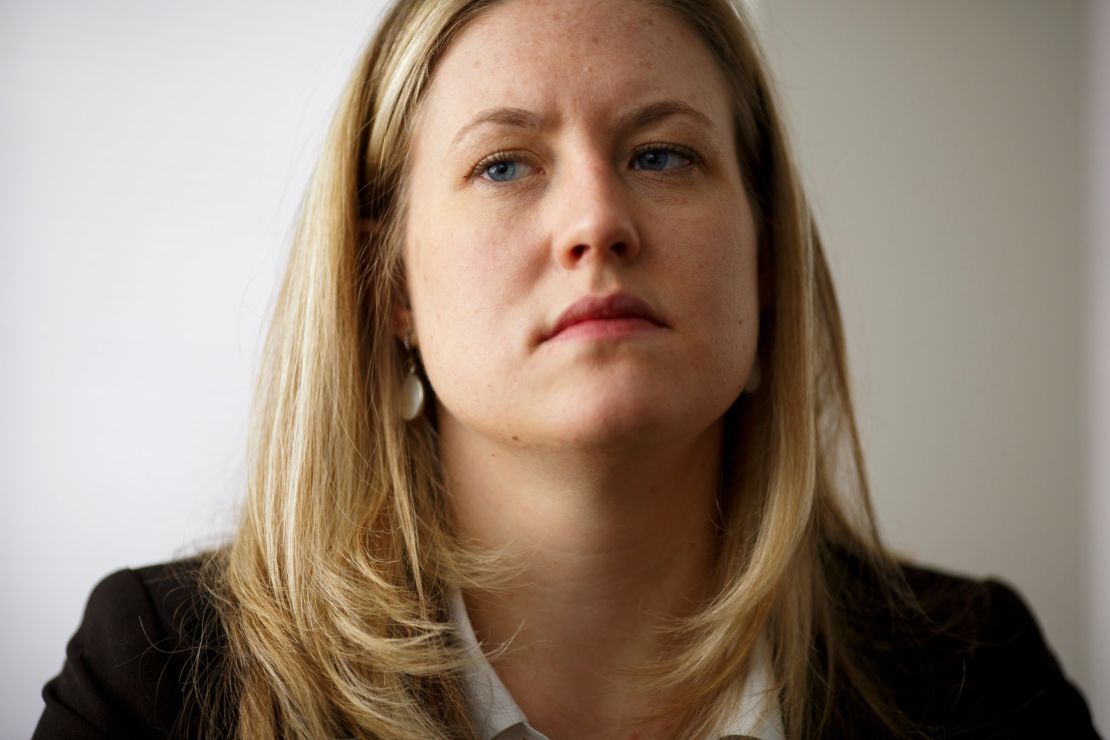
These days, though, it seems the fight for women’s equality is heating up.
Just look toward Tinseltown. Emma Watson’s now-famous September speech to the United Nations about feminism was watched millions of times. The hack of emails at Sony Pictures revealed pervasive Hollywood gender wage gaps. And then there was Patricia Arquette’s recent Oscar acceptance speech for her role as a struggling single mom in “Boyhood.” She took to the podium, calling out for equal pay and rights for women in the United States, and inspired a social media frenzy – not to mention enthusiastic cheers from Meryl Streep. In a backstage interview, Arquette specifically raised the need for the constitutional amendment.
Meantime, there’s a new book and soon-to-be completed documentary about the ERA, both titled “Equal Means Equal.” And, in the midst of these coordinated efforts, lawmakers who’ve sponsored previous attempts to resurrect the ERA plan to publicly stand together at the U.S. Capitol when they reintroduce their bills in the coming weeks.
Sure to be there cheering them on will be activists like Hager, millennial women inspired by those who’ve walked before them. The question hanging over them: Will this time be different?
Necessity or waste of time?
A toasty and crowded wood-paneled room, high up in Manhattan’s Yale Club, buzzes with experience and credentials.
Taking a break from writing her latest book is Gloria Steinem, arguably the most recognized name and face in feminist activism. Walking by is Robin Morgan, a poet and writer whose 1970 anthology, “Sisterhood is Powerful,” helped galvanize a movement. Shaking hands is Democratic Rep. Carolyn Maloney of New York, who has been introducing the ERA in every congressional session since 1997.
Others in the room are high-powered attorneys, heads of foundations and nonprofits, local government insiders. Since the time of the last ERA push, the percentage of women in the workforce has grown. In 1970, nearly half of mothers stayed home. As of 2012, less than 30% do, according to the Pew Research Center. That shift helps drive a tide of interest in equal opportunities and pay, supporters say.
Women who work full-time earn 78 cents for every dollar earned by their male counterparts, a raise of just about 19 cents since President John F. Kennedy signed the Equal Pay Act of 1963. For women of color, the picture is worse, with black women making 64 cents and Latinas making 56 cents for every dollar earned by a white man.
The face of ERA opposition during the last big go-round isn’t swayed by such figures; in fact, she calls them lies. Phyllis Schlafly, the 90-year-old conservative activist who founded the Eagle Forum, insists gender-neutral employment law already protects women doing equal work with equal experience.
The ERA is “dumb and offensive,” she tells me in a phone call. And a new push for it is “a colossal waste of time.”
Schlafly once warned that the ERA would lead to same-sex marriage and women being drafted into combat. She also said it would threaten families, an argument she still makes. She touts the virtues of the traditional nuclear family with a gender-division of duty, wherein husbands provide and wives focus on the home and children.
“But didn’t you go to law school? Weren’t you a lawyer?” I ask.
“I only went to law school to irritate the feminists,” she says with a laugh.
Schlafly also was interviewed by Kamala Lopez, the actress, director and activist who established the ERA Education Project and is behind the forthcoming documentary, “Equal Means Equal.”
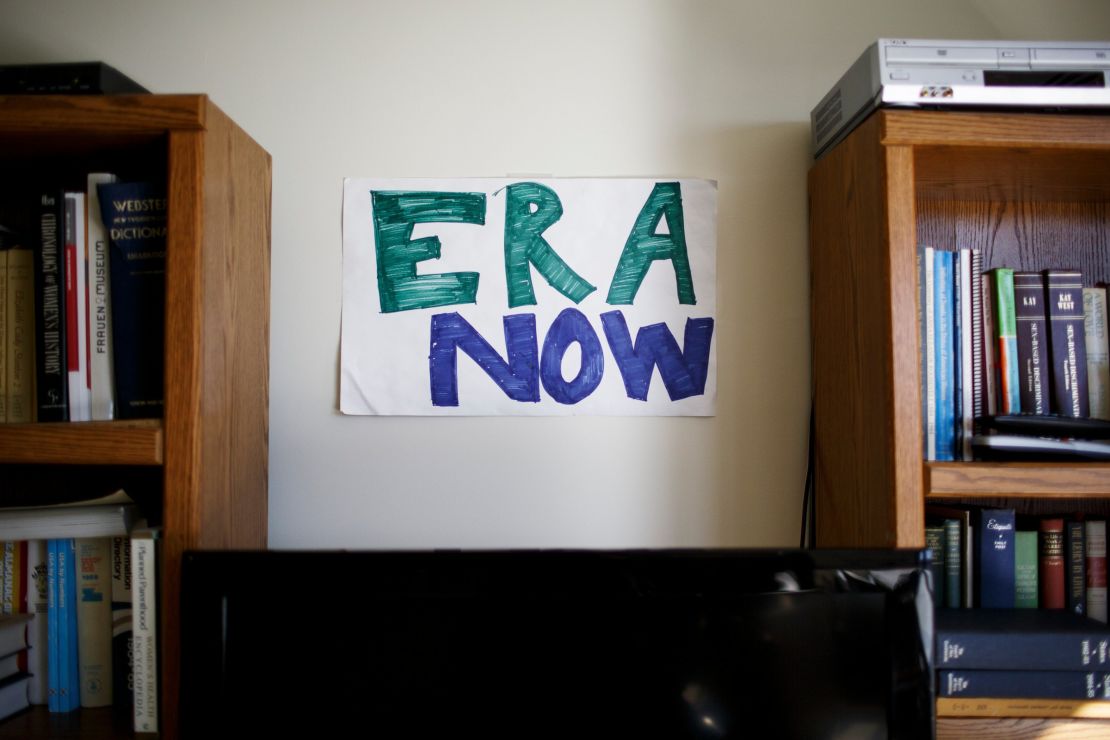
She told Lopez, “Women like the pay gap.” And she talked about hypergamy, the notion of marrying up, saying if a man doesn’t earn as much as a woman, it is a “deterrent to marriage.”
The women gathered at the Yale Club in New York scoff when they hear Schlafly’s name. They care about issues beyond gender roles and pay equity. They chat over wine and hors d’oeuvres about the injustice of piled-up, untested rape kits. They voice outrage that National Football League star Ray Rice was not prosecuted in New Jersey for assaulting his then-fiancée. They commiserate with each other about ways they still must educate trial lawyers and judges about sexual harassment and assault cases, offering examples like, “No, you can’t ask if her skirt was too high.”
Weaving past these women and men – mostly older feminists with deep pockets – is Hager. She, too, has come here this biting-cold January evening to support the ERA Coalition and celebrate the release of the new book, “Equal Means Equal: Why the Time for an Equal Rights Amendment is Now,” written by the coalition’s founder and president – and Hager’s colleague – Jessica Neuwirth.
A women’s rights lawyer, Neuwirth established the international organization Equality Now and was a director in the U.N. Office of the High Commissioner for Human Rights. She’s spent much of her career focused on Africa, steeped in cases of genocide, sexual violence and war crimes.
She met Maloney years back during discussions about sex trafficking, and the congresswoman approached her about taking up the ERA charge. Neuwirth, 53, says she welcomes the chance to work on something close to home and, in her mind, so positive and unambiguous.
Using court cases as examples, Neuwirth sets out in her book to answer why the ERA is necessary, addressing the question she hears so often from people who assume that it already passed or that women’s rights are already covered by existing laws and constitutional language.
“It was literally just a handful of votes that stopped the ERA,” she tells the group assembled in New York. “Surely with social media and the new generation of women and men who do not believe in second-class citizenship for women, we can get the ERA across the finish line and put it in the Constitution where it belongs.”
Those around her cheer, but opponents more contemporary than Schlafly bristle at the idea of women seeing themselves as victims.
A Tumblr site and Facebook page dedicated to “Women Against Feminism” feature young women brandishing their own versions of that argument. “If I experience sexism, I stand up for myself and move on,” writes one woman. “Bitching about it will get me nowhere.”
Others warn of unanticipated fallout if the ERA passes. Parents who enroll their children in single-sex schools or organizations like the Girl Scouts or Boy Scouts may lose that choice, says Sabrina Schaeffer, executive director of the Independent Women’s Forum.
Ongoing claims about a wage gap are overblown and speak more to women’s choices than to discrimination, says Schaeffer, whose organization counts Lynne Cheney, the wife of former Vice President Dick Cheney, among its supporters.
“Women would be far better served by having an honest conversation about the things they hope to achieve and the choices they’re making along the way, from their college major to if they want to take time out of the workplace,” Schaeffer wrote me in an email, “than any kind of legislation which would make women more expensive to hire and ultimately less attractive to businesses.”
Arguments like these leave Neuwirth baffled.
“Anyone who says that paying women equally and treating them equally in the workplace makes it more expensive for businesses to hire them … is saying in effect that women are worth less than men,” she says. “Equality in the workplace is not just the right thing to do, it’s the smart thing for business and a good thing for men as well as women.”
People often assume women’s rights are secure thanks to the Equal Protection Clause in the 14th Amendment, Neuwirth says. That amendment was adopted in 1868. The mere fact that it took another five decades for women to get the right to vote, she says, proves the clause wasn’t about them.

And laws bearing names like the Pregnancy Discrimination Act, Equal Pay Act and Violence Against Women Act may sound great, but they’re not ironclad guarantees of protection.
In her book, Neuwirth outlines stories of women who have tested the power of federal statutes. One had been raped in college, only to see an admitted attacker go unpunished. Another took out a restraining order against her violent husband, who went on to kill their three daughters. In both instances, the women sued authorities for failing to act and took their cases all the way to the U.S. Supreme Court, only to be told there was no constitutional basis for their protection.
Other court decisions have justified unequal pay for identical work, as well as the firing of women from jobs they were still capable of doing simply because they got pregnant.
Women who think their interests are sufficiently protected, Neuwirth tells the Yale Club gathering, have been duped by a fairy tale.
“Who would know that better,” she says, “than Supreme Court Justice Antonin Scalia?” She cites what he told California Lawyer in a January 2011 issue: “Certainly the Constitution does not require discrimination on the basis of sex. The only issue is whether it prohibits it. It doesn’t.”
A battle rich in history
Last April, Scalia appeared at the National Press Club beside his judicial polar opposite – and friend – Supreme Court Justice Ruth Bader Ginsburg. The two were asked how they would amend the Constitution, if they could.
The Notorious R.B.G., as she is sometimes referred to these days, didn’t hesitate.
“If I could choose an amendment to add to this Constitution, it would be the Equal Rights Amendment,” she said.
“What do you mean by that?” asked the moderator, Marvin Kalb.
“It means that women are people equal in stature before the law,” she said. “We have achieved that through legislation, but legislation can be repealed. It can be altered. … That principle belongs in our Constitution. It is in every constitution written since the Second World War.”
When her granddaughters pick up the U.S. Constitution, Ginsburg added, she’d “like them to see that that is a basic principle of our society.”
The idea of an Equal Rights Amendment in the United States isn’t new. It was the brainchild of Alice Paul, a suffragist leader who fought hard to pass the 19th Amendment, earning women the right to vote in 1920.
Believing that wasn’t enough to end discrimination, Paul then drafted the ERA and introduced it to Congress in 1923.
From then until 1970, the amendment was presented during every congressional session. Over the years, it enjoyed bipartisan support. For decades it stayed on the Republican platform. But it rarely made it out of committee. A growing women’s movement in the late ’60s and early ‘70s set out to change that.
In 1972, the ERA passed by the necessary two-thirds vote in both the House and Senate, was endorsed by President Richard Nixon and then sent to state legislatures for ratification.
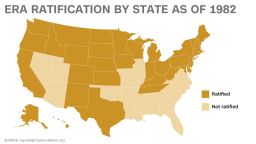
The key language, tweaked from Paul’s original version, read:
Equality of rights under the law shall not be denied or abridged by the United States or by any State on account of sex.
To pass an amendment, three-quarters of the states – or 38 of them – must ratify it. There was a deadline tied to this effort, though; at first seven years, then extended to 10. By the time 1982 rolled around, 35 states had ratified the ERA. The amendment failed to pass, falling three states short.
The fight on the national stage grew quiet, but the ERA has been reintroduced every congressional session since then. With the exception of 1983, when House representatives voted on it once more, the ERA has never again made it out of committee and onto the floor for a vote.
Rep. Maloney hopes this year will shift the tide.
“I spend 75% if not more of my time fighting to hold on to what we [women] already have, not advancing to the next level,” Maloney says. “This is going to be the decade of the woman. We need to pass it by 2020 and finish the job.”
The last time the U.S. Constitution was amended was 1992. The 27th Amendment prohibits members of Congress from giving themselves pay raises during the session in which they are currently serving.
That amendment was introduced by James Madison and sent to the states for ratification in 1789. More than 202 years later, it passed.
When Maloney and her colleagues reintroduce the ERA, they will present two strategies.
Democratic Rep. Jackie Speier of California and Democratic Sen. Ben Cardin of Maryland will introduce legislation to lift the 1982 deadline – a hurdle clearly not faced when it came to the 27th Amendment. That would put the ERA three states shy of success.
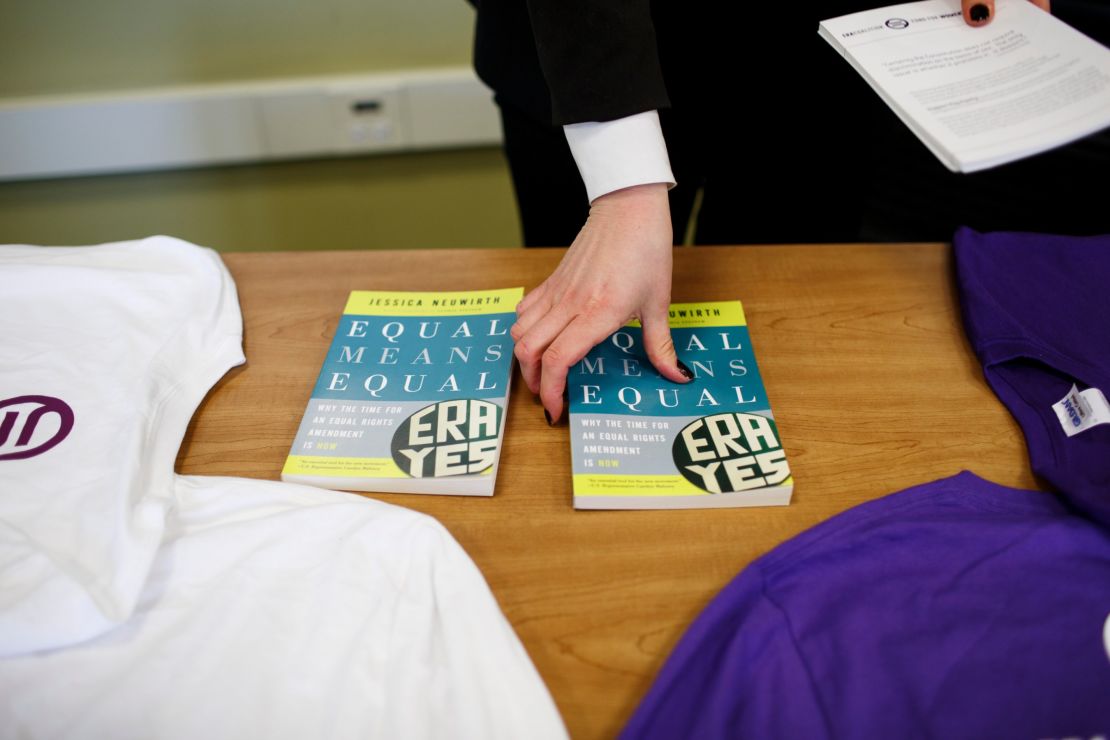
Maloney will propose starting the ERA process from scratch. Embattled Democratic Sen. Robert Menendez of New Jersey, who took up the charge after Democratic Sen. Ted Kennedy died, is expected to do the same.
There’s no downside in pitching both strategies at once, they all say. The lawmakers are not in competition. They’re just trying different approaches to see what will take.
The need, they say, is as evident today as ever. While more than 80% of countries guarantee gender equality in their constitutions, the UCLA’s WORLD Policy Analysis Center found, 32 do not, including the United States.
Facing the opponent early
A sign on the wall reads, “An equal society is a happy one.” Gathered are about 20 members of a local feminism club. Some rush to finish their lunches of burgers, greasy fries and salads, hinting at their busy schedules.
Hager usually spends her days building relationships, talking to staffers on the Hill and joining constituents in meetings with lawmakers. She crafts fact sheets, beats the ERA drum via social media and volunteers for speaking engagements.
Often that means talking to groups of adults. Today, though, most of her audience isn’t old enough to vote.
She has taken her women’s history lesson and message to a posh Washington-area private academy, The Field School, where she’s been invited to address a room full of teens – including Jessica Neuwirth’s nephew.
“I’m not sure if anyone knows who Justice Scalia is,” Hager says near the top of her talk, gearing up to share his oft-repeated quote.
“I play tennis with him!” a boy blurts out. “He goes to our club.”
The unexpected answer leaves Hager stunned and smiling. The only answer she can come up with: “Well, can you tell him to help us out?”
The students want to know what they can do, beyond hit up a Supreme Court justice for support.
“There is so much creativity in your minds, and we need to find ways to reach out,” Hager tells them.
“That ice bucket thing [for ALS] took off so fast,” says James Barringer, 15, Neuwirth’s nephew and the brains behind a Facebook group called Boys and Men for the ERA. “Maybe we can come up with something like that?”

One student fixates on the ERA’s language and suggests it should read “regardless of assigned or perceived gender or sex,” rather than just “regardless of sex.” Another asks about the new movement’s greatest opposition.
“The main opponent we face is lack of knowledge,” Hager says. “Seven out of 10 Americans think we already have it. Nine out of 10 think we should have it. Why don’t we have it? Because seven out of 10 think we do.”
Dozens of organizations are active in the ERA Coalition: A Call to Men, the YWCA, the National Congress for Black Women, to name a few. They may have representatives enlisted to work on the cause, but the ERA is Hager’s one and only focus.
Beyond her job, Hager co-chairs the ERA Task Force of the National Council of Women’s Organizations. Her partner in this effort – and one of her mentors – is 72-year-old Roberta “Bobbie” Francis. While so many women her age burned out or moved on after the 1982 deadline, Francis remained engaged.
In 1981, she wrote a flier, “Why We Need the ERA,” which was nationally distributed by the League of Women Voters. But Francis got involved a little late and wasn’t on the front lines. “I joined a marathon at the 13th mile,” she says. Maybe that’s why she’s lasted. Or maybe it’s simply her personality?
“I think the word you’re looking for is bullheaded,” she says with a laugh. Whatever the case, she’s kept on.
Francis established and runs equalrightsamendment.org, a repository for all things ERA. And it was she who recommended Hager for the ERA Coalition position when Neuwirth began looking.
It’s no small responsibility to Hager.
“If I mess up on the Hill, I could hurt 51% of the population,” she says. “Why do you think I’m so hard on myself? I take it very seriously.”
Jolted to attention
At the popular Tortilla Coast on Capitol Hill, Hager sits down for a lunch of fajitas, chips and guacamole surrounded by half a dozen colleagues-in-the-cause she counts as friends. All these women, with the exception of one, were born after 1982 – and into a world where rallying cries for the ERA had been reduced to a whisper.
Most of them, including Hager, were jolted to attention in college when they took women’s studies courses. That’s how they first learned there was no ERA and nothing in the U.S. Constitution to specifically protect them as women.
“Wait, what? Are you sure?” Kristina Romines, 25, the field coordinator for the National Organization for Women (NOW), remembers saying as she exchanged wide-eyed stares with other startled students. “I almost asked my professor to double check.”
It’s the sort of WTF response they say they hear from peers, women and men alike, over and over. And it matches what polls have shown.
A 2001 survey conducted by the Opinion Research Corporation showed that 96% of U.S. adults believe women and men should have equal rights, and 72% believe the Constitution already guarantees those rights.
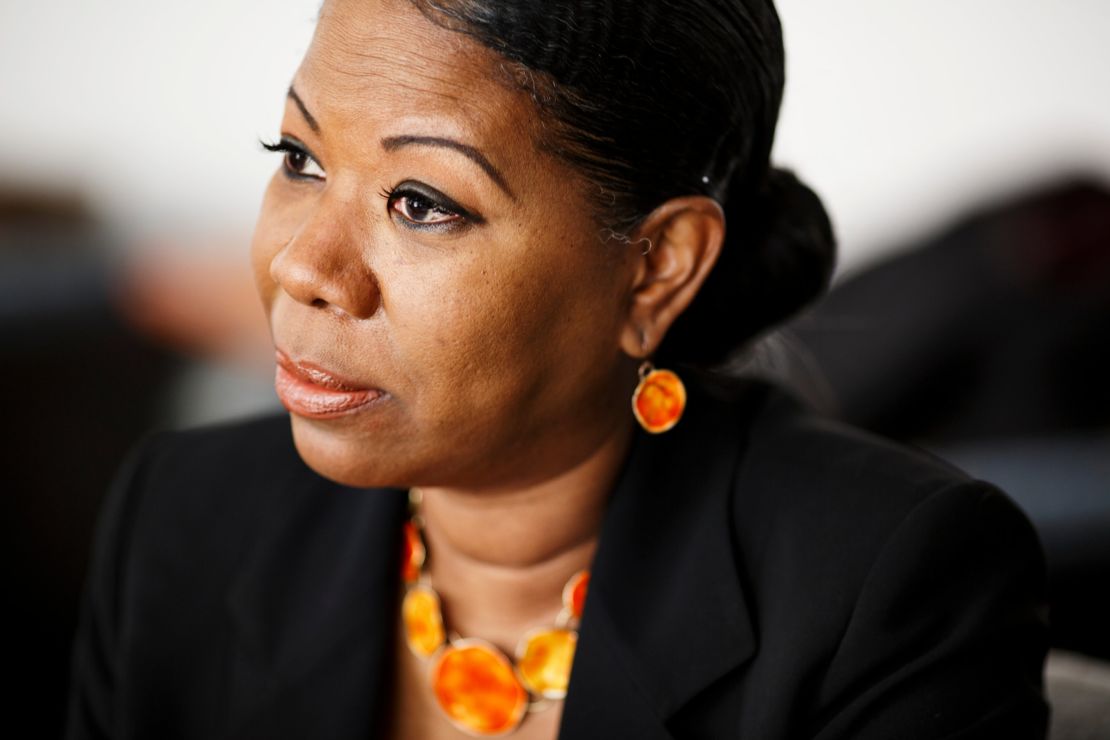
The problem, ERA proponents say, is that this simply isn’t true. That the ERA isn’t already in the Constitution strikes these women as ludicrous. It should be a no-brainer, they say.
These women thank their fathers, who were their cheerleaders. At least one speaks of being raised by a single mother, another by a single father after her mother died young. Several mention husbands who share the load at home – and share their outrage.
They talk about how to stir up widespread support, the importance of education, the need for constituents to contact their members of Congress. And they find hope in what’s brewing around them: The growing efforts to address sexual assault on college campuses. The higher-than-ever number of women in Congress. The fact that a woman is one party’s presumed presidential nominee.
They shake their heads about the hypocrisy of the United States pushing other nations – including Afghanistan – to protect women in their constitutions while not doing the same at home. While they applaud how same-sex marriage is poised to be protected by the highest court, they are a bit dumbfounded that the same court says it has no constitutional basis to protect them. Frankly, they feel like they got passed over.
“Societally, our generation is there,” insists Chitra Panjabi, 30, NOW’s membership vice president. “The structure needs to catch up.”
While ratifying the ERA would certainly be symbolic – a statement to the nation and the world that women in America matter – these activists insist the need is real.
Just look at the recent flood of state legislation meant to chip away at reproductive rights, they say. See how religious freedoms trumped women’s rights when the Supreme Court allowed Hobby Lobby to refuse comprehensive birth control coverage. Peek into corporate boardrooms and notice the dearth of female CEOs.
Pay and other inequities hurt women – and, by extension, families and communities (including men). Victims of domestic violence are less likely to leave if they can’t stand on their own feet financially. And a lifetime of wage discrimination means women and their families also pay a price later when it comes to Social Security benefits.
They marvel about those who fought before them, like the suffragists who endured beatings, arrests and hunger strikes so women could earn the right to vote.
“Alice Paul showed up and said, ‘I’m going to march on Pennsylvania Avenue,” says Panjabi. “That’s badass.”
They can’t fathom why anyone elected to serve in Congress would oppose the ERA.
“It’s hard to vote against equal rights for women and then expect women to vote for you,” says Gaylynn Burroughs, 36, director of policy and research at the Feminist Majority Foundation.
They feel strange sitting here, speaking on behalf of this fight. It’s as if they’re instinctively waiting for their mentors to do the talking – women like Burroughs’ boss, Eleanor “Ellie” Smeal, who has been waging battles for women’s equality for more than 40 years.
Bolstering the bandwidth
The offices of Smeal’s Feminist Majority Foundation in Arlington, Virginia, are abuzz with interns doing research, planning outreach, organizing reports. On the walls of one workroom are handwritten reminders of why they do what they do.
“I need feminism because … People didn’t believe I could be a cheerleader and valedictorian,” reads one. “I need feminism because… It’s 2014 and old white men are still trying to write laws that control my body,” says another.
Smeal, 75, walks the hallways checking in with her young warriors, striding past a poster for the 2004 “March for Women’s Lives.” There’s a framed Ms. Magazine cover – Smeal is the publisher – which reads “Wonder Woman for President.” An image of Rosa Parks features her quote, “My sole concern was to get home after a hard day’s work.” A sketch of the late Chief Justice William Rehnquist is emblazoned with the words, “Gag me with a coat hanger.”

In a conference room that doubles as a library for all-books-feminist-activist, the political analyst and strategist regales her protégé Burroughs – joined today by Hager and other guests – with war stories. She was president of NOW during the last big battle to ratify the ERA.
She took part in a silent vigil on the steps of the Capitol, while “little boys from the Boy Scouts yelled at us to get back in the kitchen,” she says, laughing at the absurdity of it all. “These little twerps, and their parents wouldn’t say anything. And there we were like schmucks not talking. It was awful!”
She details an Indiana march through a blizzard, the all-nighters in a Nevada library doing frenzied research, the ongoing struggle to find female lawyers to work with and a female CPA to do NOW’s books. She cracks up recalling how befuddled she and her cohorts were by negative media coverage, until they remembered they were suing all three networks and many newspapers for discriminatory practices.
Smeal insists the real enemy was never Phyllis Schlafly; it was big business – “We’re the cheap labor pool” – and insurance companies. Before the Affordable Care Act, women paid about $1 billion more than men each year in the individual health insurance market, according to the National Women’s Law Center. And only 3% of the plans they had covered maternity services.
Reflecting on the last big ERA fight, Smeal says she and others in the core group knew their odds were bad. But they were building something bigger; it wasn’t just one fight. They were an extension of a movement that began years before.
When she first met Alice Paul, it was in the wee hours of the night at the National Women’s Party building. Smeal and others from the Pittsburgh NOW chapter woke up Paul, who came to the door in a nightgown. Smeal says she was mortified, especially after Paul ran to fetch a bell and started ringing it.
“If you’d waited 50 years for reinforcements, you’d be excited, too,” she remembers a friend saying.
In the new reinforcements represented by Hager and Burroughs, Smeal sees all that is possible.
While she and her comrades once shut down Western Union when they sent 400,000 telegrams during a march on Washington, today’s movement is bolstered by the bandwidth of the Internet and tools like Twitter.
Back in the day, it would take a week to move from a new idea to a mailing and require the help of children to stuff envelopes. These days, activists can blast out a fresh message to millions in minutes.
While only 12 women held seats in the U.S. Congress, now there are 104. Factor in women elected to offices across the country, Smeal says, “You couldn’t get them all in one room.”
Today, battles are being waged and won locally – and don’t require national mobilization. Oregon stands out as an example, having passed an Equal Rights Amendment to the state constitution in a landslide vote in November.
“The movement will grow. And the first good shot we get, you can bet we’ll take it,” Smeal says of the national ERA effort. “I see it as an intergenerational fight. I don’t know if I’ll be there. I don’t know who will be there. But I know one thing: When we go over the top, we’re going to need everybody.”
Driving forward
Hager’s sensible black pumps are killing her as she climbs into a cab after a long day on the Hill. She’s greeted with a surprise that energizes her: At the wheel is only the third female taxi driver Hager has seen in her six years in Washington.
The cabbie, who’s been at this job for 29 years, isn’t fazed. If she had a penny for every passenger who has said they’d never had a female cab driver before, she says, “I’d be a rich somebody.”
Instead, she gets fired up describing the men who’ve challenged her. Some say she’s taken away their jobs. Others, when she was pregnant, accused her of not having a good husband because she works.
“I could go on and on and on,” she says, asking that her name not be used. “I give them a piece of my mind, and that’s why I don’t have much of one anymore.”
What got her on this roll is simple: Hager let her in on the not-so-secret fact that the ERA never passed.
“What are you saying?” the cabbie shrieks, her eyes wide. “I thought I was well educated. You’re tripping me out! What do you mean I don’t have equal rights?”
Now it’s Hager’s turn to be unfazed. She and her compatriots have seen this response so many times before. So she smiles, leans in from the back seat and begins to explain.








